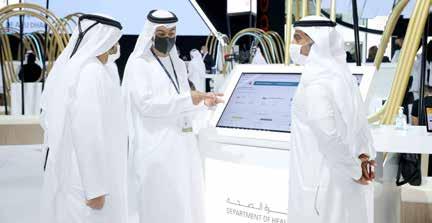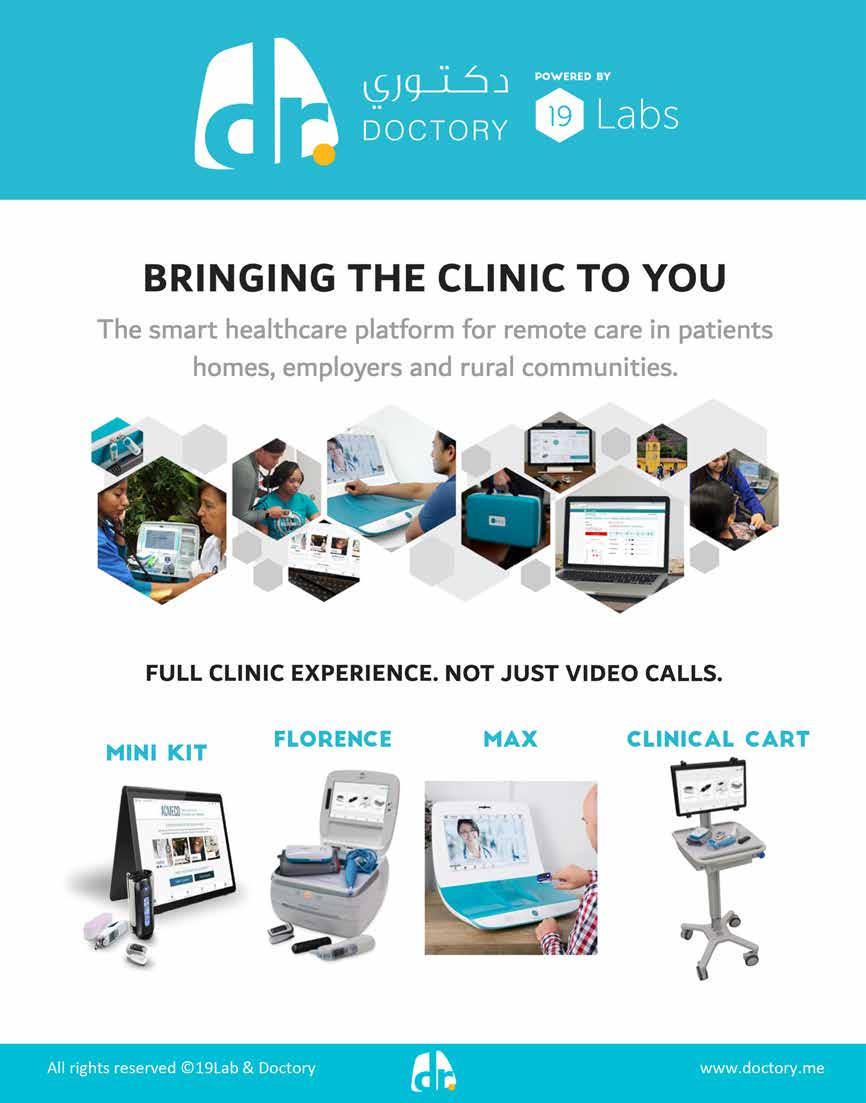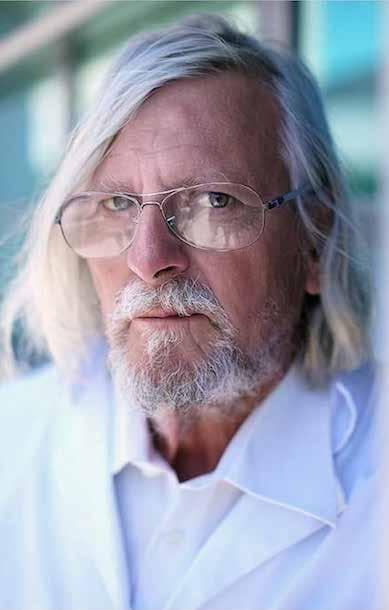
9 minute read
Malaffi platform to use predictive analytics technology
Malaffi platform to use predictive analytics technology to improve the health of Abu Dhabi residents
The Department of Health – Abu Dhabi (DOH) and Malaffi, the region’s first Health Information Exchange (HIE), showcased a population risk management analytics platform at GITEX. The technology will empower the healthcare sector to support care management, improve population health and assist in ensuring continuity of care.
Advertisement
The risk management solution, which is supported and provided by Malaffi, uses advanced AI analytic technologies such as machine learning, to build predictive models based on the clinical data and create algorithms that run in near real-time to predict cost, admissions, emergency department visits, readmissions, and diseases. Drilling down from the population to the physician and individual level, the insights will be used to predict risk, improve overall efficiencies and health outcomes.
The analytics dashboards will enable the DOH to gain insights into and manage certain risk categories such as risk of emergency room visits or complications of chronic conditions such as diabetes. It will further visualise the population risk distribution and trends and will provide benchmarking against best practice guidelines. For the first time, real-time monitoring of health indicators and new data points will be available to improve quality through customised benchmarks, in addition to standard performance and utilisation reports. Malaffi currently connects MALAFFI WAS LAUNCHED IN 2019 AS PARTNERSHIP BETWEEN THE DEPARTMENT OF HEALTH – ABU DHABI AND INJAZAT. MALAFFI IS WORKING TO CONNECT ALL, MORE THAN 2000, HEALTHCARE PROVIDERS IN ABU DHABI BY 2021.
almost 83% of all hospitals and a total of 814 healthcare facilities in Abu Dhabi, which accounts for 77% of all episodes in the Emirate. The centralised database stores 175 million patient records, for over 5 million unique patients.
Commenting on the new developments, H.E Dr. Jamal Mohammed Al Kaabi, Undersecretary of the Department of Health – Abu Dhabi, said: “We are proud to have built a healthcare infrastructure that is on par with the most advanced in the world. The addition of such sophisticated analytic technology to Malaffi is further testament of the DOH’s dedication to improving outcomes for the people of Abu Dhabi. Adoption of the latest technological advancements, which support further improvements to patient care, has always been a key part of our ambitious journey, and reaffirms the Emirate’s position as a true healthcare technology leader. Access to insights that support management of the health status of the population, will strengthen our response to public health risks and enhance the Emirate’s emergency preparedness, and ultimately ensure excellence in healthcare now and in the future.”
Mr. Atif Al Braiki, Chief Executive Officer of Abu Dhabi Health Data Services said: “Malaffi is the first HIE in the MENA region, and thanks to the support we have had from the Abu Dhabi healthcare sector, in a short time we have demonstrated the true value that connected healthcare can offer all our stakeholders. The addition of such sophisticated analytics platforms only expands on the benefits that Malaffi offers and maximises the data collated. Advanced technologies such as this will provide insights that will empower both the DOH and healthcare providers, to improve their population health and care management efforts. The ability to analyse large data sets to identify risk at an early stage and by improving overall efficiencies, we can be one step ahead in improving quality of healthcare and outcomes for our patients. The next stage in the Malaffi journey is an exciting one.”
SENER is working with the Severo Ochoa Center for Molecular Biology (CSIC-UAM) to detect the SARS-CoV2 virus in enclosed spaces
SENER, responsible for the innovative RESPIRA® system to improve ventilation inside facilities, has signed a contract with the CSIC, and specifically with the Severo Ochoa Center for Molecular Biology, to use the capabilities of the RESPIRA® control system to verify how ventilation affects the risk of contagion in enclosed spaces and to detect SARS-CoV2 in air samples.

This collaboration between SENER and the CBMSO (CSIC-UAM) started in October, sponsored by the Deputy Office for Knowledge Transfer (VATC in its Spanish Acronym) of the CSIC. Since then, teams of engineers and scientists from both entities have been working together to produce an effective control system that reduces the risk of contagion from Covid-19 in enclosed spaces, which will be compared against measurements taken by the CBMSO (CSIC-UAM). If the system is shown to work correctly, it could be installed in spaces where large numbers of people congregate, such as airports, stations, public transport vehicles, shopping centers, sports stadiums, auditoriums, schools, hospitals, museums, exhibition centers, etc.
RESPIRA® is an artificial intelligence platform that is capable of improving the air quality inside an enclosed structure by defining several criteria and reading parameters in real time, such as the indoor temperature, humidity and air quality, and the efficiency of electrical consumption. These data are used by a dynamic algorithm to
The SENER engineering and technology group and the Spanish Council for Scientific Research (CSIC) have signed a partnership agreement to jointly develop a project to identify the risk of contagion from SARS-CoV2 in enclosed spaces. Under this agreement, SENER is providing its RESPIRA® artificial intelligence system, which can be used to dynamically control ventilation in enclosed spaces. The Severo Ochoa Center for Molecular Biology (CBMSO, CSICUAM) is providing its equipment for capturing airborne viruses and microorganisms, as well as its procedure for identifying SARS-CoV2 in filters using optimized PCR methods.
predict the environmental conditions (depending on the weather forecast, the service to be provided and other factors) and then apply a mode of operation to the ventilation units in order to ensure the air quality and lower the heat index, while also minimizing electricity consumption inside the structure.
SENER's Innovation Director, Òscar Julià, says that "RESPIRA® applies smart ventilation control to maximize the supply of fresh, outside air to enclosed, complex spaces, such as shopping centers, airports, train stations and hospitals, reducing the risk of proliferation of microorganisms. In this regard, this collaboration with the CBMSO (CSIC-UAM) is going a step further in detecting the SARS- CoV2 virus in the air. As a result, we hope to be able to offer the users of these facilities a system to guarantee a safer space with the lowest possible risk of contagion."
And he added: "At SENER, we view the digital transformation as integrating new technologies into the environment, the ultimate goal being to make them available to society. We are looking for sustainable and environmentally friendly innovations that can improve people's lives. RESPIRA® is an example of how an Artificial Intelligence solution can help mitigate the impact of this pandemic."
For Antonio Alcamí, a CSIC researcher involved in the project: "This collaboration is an opportunity to complement the system developed by SENER and the methods for detecting airborne SARS-CoV2 that we have optimized at the CSIC in order to reduce the risk of contagion and improve our health."
For Ángela Ribeiro, Deputy Vice-President of the CSIC Knowledge Transfer: "The CSIC has once again shown its strong commitment to the effective transfer of the quality work carried out in its centers and institutes. In this case, we looked for the appropriate framework to establish an important public- private partnership that is already starting to yield results."
Diabetes Technology: The Dexcom G6 Makes Its Regional Debut at GluCare Integrated Diabetes Center
GluCare Integrated Diabetes Center, the world’s first healthcare provider to empower patients through Remote Continuous Data Monitoring as part of its standard care model, and the region’s first healthcare provider to use Digital Therapeutics, is announcing that it is the first in the region to offer diabetes patients the Dexcom G6 Continuous Glucose Monitor (CGM).

First introduced to diabetes patients in 1999, CGMs are wearable technology that track the wearer’s glucose levels throughout the day and night. Unlike the traditional blood glucose monitors (BGM) that provide a single reading at a particular moment via a fingerstick, CGMs provide dynamic and real-time information on the wearer’s blood glucose levels. For those with diabetes, keeping their blood glucose levels in an acceptable range is a key part of maintaining health. Blood glucose data also signals diabetes patients when to take insulin and other medications, and as part their self-management, helps them to avoid various serious, and potentially fatal, complications. Among the key benefits of the Dexcom G6 CGM is that the new model eliminates the need for fingerstick calibration which previously would see users draw blood via a fingerstick, twice daily. Used within GluCare’s model of care, the center’s team of healthcare professionals are able to track patient's glucose readings, and correlate them with their movement, diet, weight, physiological parameters, mental wellbeing and sleep patterns.
All data, including that of the G6 is collected and collated in a proprietary phone app that, combined with self-reported factors such as photos of meals and questionnaires, are sent back in real-time to GluCare’s team of experts. The data is also subject to artificial intelligence and machine learning to identify individual risk factors for various diabetes complications or comorbidities. GluCare’s expert care team of doctors, health coaches and nutritionists have access to this information in realtime, allowing them to make timely decisions regarding the patient’s care – especially between routine visits.
For GluCare Co-Founder and Managing Director, Dr Ihsan Almarzooqi, there is an immediate and pressing need for new and improved diabetes technologies and care models as the number of diabetics in the MENA region is expected to grow from 55 million, to 108 million by 2045: “Diabetes is a 24/7 condition that requires a tremendous amount of self-management and as we can see from the rapidly growing prevalence, current models of care and technologies have not kept pace until now. At GluCare we use technology to empower both our patients and us, as providers with comprehensive, real-time data. The Dexcom G6 is a game-changing diabetes management technology that fits perfectly into our model of care as it not only provides more precise data but does so in a way that reduces additional self management.”
Among the other benefits of the Dexcom G6 are new customizable alerts and alarms, including a new Urgent Low Soon alert which can warn users up to 20 minutes in advance of an urgent hypoglycemic event, so they can take steps to prevent it, a 10-day sensor allowing for longer wear (3 days longer than the previous generation Dexcom CGM), a slimmer transmitter with a lower profile for more discreet wearability, an auto-applicator designed to make sensor insertion simple with the touch of a button, a newly designed receiver with a touchscreen display (optional display device), and a new sensor membrane that enables acetaminophen use without any effect on glucose readings. As part of GluCare’s model of care which uses both CGM and BGM technology, the Dexcom G6 will be offered to patients either on an ongoing basis, or for a set period of time, dependent individual patient requirements and care plans.
The G6 integrates with GluCare’s ‘continuous healthcare’ model seamlessly as it joins other technology within the model: a wearable “band” that measures heart rate and heart rate variability, respiration rate, physical activity, skin temperature, and sleep patterns; and dependent on individual patients, a smart blood pressure monitor and smart weight scale.











